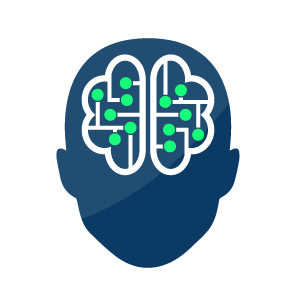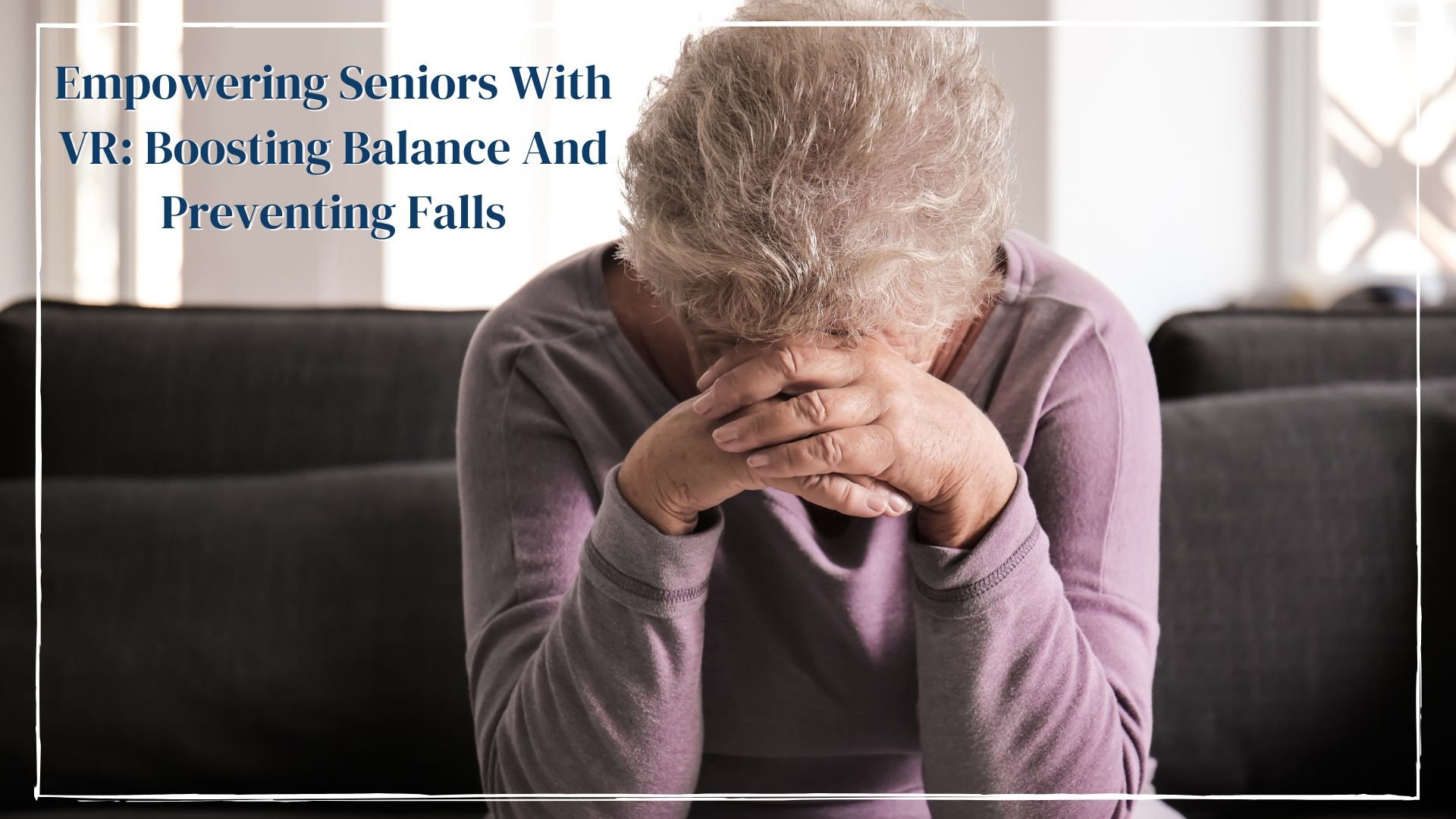Empowering Seniors With VR: Boosting Balance And Preventing Falls
Written by: Brianna Hodge
As we age, certain aspects of life begin to change—subtly at first, then more noticeably over time. You might catch yourself hesitating at the top of a staircase, avoiding uneven terrain, or reaching for handrails in places you never used to. Walking through a grocery store might feel like navigating an obstacle course, and simply standing from a seated position can become an act of careful calculation. You’re not alone in noticing these shifts. According to the CDC, one in four Americans aged 65 and older falls each year, making falls the leading cause of injury among older adults. With our global population aging rapidly, we are at a critical crossroads where traditional rehabilitation methods alone are not enough. We need innovative, engaging, and evidence-based solutions that meet older adults where they are. This is where virtual reality (VR) is stepping in to redefine what's possible.
What once began as a novelty in the tech and gaming industries is now revolutionizing health care. Virtual reality is no longer just about fun or entertainment—it's becoming one of the most promising tools for neuro rehabilitation and fall prevention among older adults. By merging immersive environments with clinical protocols, VR opens new pathways for safer, more effective recovery.
The Aging Brain and Body
Before diving into the transformative power of VR, let’s take a closer look at the biological and neurological realities of aging. With age comes a gradual decline in multiple physiological systems. Muscle mass diminishes, joints stiffen, and reaction times slow. Our sense of balance—governed by complex interactions between the visual system, vestibular system, and proprioception—becomes less reliable. Cognitive changes also creep in. Tasks that once required little thought, like walking while talking or navigating crowds, may now demand extra mental effort.
Despite these challenges, the brain retains a critical superpower: neuroplasticity. Neuroplasticity is the brain’s innate ability to reorganize and form new neural connections in response to learning or injury. Even in our 70s, 80s, or 90s, our brains can adapt, provided they are given the right stimulation. This is the scientific foundation upon which modern neuro rehabilitation is built—and VR is uniquely positioned to enhance and accelerate this process through repetitive, engaging, and task-specific activities.
How VR Enhances Rehab
Unlike traditional rehab, which may involve monotonous and repetitive movements in sterile clinical environments, VR turns therapy into a multi-sensory experience. In a VR setting, older adults are transported into fully immersive, interactive environments designed to stimulate both physical and cognitive functions. These scenarios are not only more stimulating but also highly customizable to match each patient’s specific goals and limitations.
Research study:
A 2024 systematic review titled “Effectiveness of Virtual Reality Therapy on Balance and Gait in the Elderly” further reinforces the growing body of evidence supporting VR in neuro rehabilitation.
This comprehensive review analyzed multiple randomized controlled trials comparing immersive VR therapy to conventional physical therapy. The findings were striking: older adults who engaged in immersive VR balance training demonstrated significantly greater improvements in postural control, dynamic stability, and functional mobility than those receiving traditional interventions.
The review concluded that immersive VR is not only effective but may also surpass conventional physical therapy in addressing balance deficits among elderly populations. These results highlight the unique capacity of VR to create realistic, engaging environments that challenge both the sensory and motor systems simultaneously, fostering more meaningful neuroplastic adaptation in aging individuals (Rodríguez-Almagro et al.).
Through VR, patients can perform repetitive, task-specific training—a gold standard in neuro rehab. For instance, walking along a virtual path dotted with uneven terrain or stepping over virtual puddles requires precise motor control and decision-making. Meanwhile, therapists can adjust the difficulty level in real time, ensuring patients are appropriately challenged without being overwhelmed. These VR sessions function like high-tech, interactive simulations, keeping patients safe while exposing them to real-world scenarios they might face.
Real-World Application: The Case of Fall Prevention
Fall prevention is one of the most urgent issues in geriatric care. Traditional programs often emphasize strength and balance training, which are undeniably effective—but adherence is a persistent problem. The reality is that repetitive, static exercises in an uninspiring setting can quickly lead to disengagement. Virtual reality reinvents this model by infusing therapy with purpose, exploration, and even joy.
Research Study One:
Although originally designed for individuals with multiple sclerosis, the protocol outlined in “A Multi-Modal Virtual Reality Treadmill Intervention for Enhancing Mobility and Cognitive Function in People with Multiple Sclerosis” underscores the broader applicability of combining treadmill walking with immersive virtual environments.
This randomized controlled trial proposed a multi-modal approach where participants engaged in treadmill walking augmented by VR simulations, aiming to improve not only physical mobility but also cognitive functioning. The rationale is that when physical activity is paired with immersive and interactive environments, the brain is simultaneously challenged to process spatial cues, make decisions, and adjust movements in real time.
While the trial focuses on people with MS, the principles of cognitive-motor integration and dual-task training are directly relevant to older adults facing similar declines. The study exemplifies how combining treadmill training with VR creates a richer, more effective rehabilitation experience that targets both the body and the brain (Hsieh et al.).
Research Study Two:
Adding to the growing evidence, a randomized controlled trial titled Effect of Virtual Reality Exercises on Balance and Fall in Elderly People with Fall Risk provided compelling data on the preventative impact of VR interventions.
The study involved elderly participants identified as having a high risk of falls, who were divided into intervention and control groups. The intervention group engaged in structured virtual reality exercises over the course of several weeks. At the conclusion of the trial, participants in the VR group showed statistically significant improvements in both balance scores and fall reduction compared to the control group, who received standard care.
The authors concluded that virtual reality not only enhances physical performance but also contributes meaningfully to fall prevention strategies by engaging users in dynamic, targeted movements that mirror real-world challenges. This study reinforces VR's role as a clinically effective tool in reducing fall risk among older adults (Zahedian-Nasab et al.).
The Power of Cognitive-Motor Integration
Mobility is not just about muscle strength or joint flexibility—it’s deeply intertwined with cognitive function. As we age, our ability to process multiple stimuli simultaneously, shift attention quickly, and make split-second decisions diminishes. These cognitive declines can make everyday activities like crossing the street or responding to a sudden obstacle significantly more dangerous.
VR helps retrain these crucial functions through cognitive-motor integration. In a virtual grocery store, for example, a patient may be asked to locate and retrieve specific items while walking through aisles. This requires attention, memory, and decision-making—all while maintaining balance and movement. By gradually increasing the complexity of these tasks, therapists can systematically improve the patient’s dual-tasking capabilities.
Over time, this type of training helps build neural resilience. It creates stronger communication between the brain regions responsible for movement and those involved in cognitive processing. This not only reduces fall risk but also enhances overall functional independence, giving older adults the tools to live more safely and confidently.
Mental Health Benefits for Older Adults
Aging isn’t just a physical journey; it’s an emotional one too. Many older adults struggle with feelings of isolation, depression, or anxiety—particularly when physical limitations reduce their ability to engage in social or recreational activities. Mental health challenges can further diminish motivation to participate in rehab, creating a cycle that worsens both emotional and physical health.
Research Study One:
The emotional and psychological impact of virtual reality on older adults is further illustrated in a study titled Impact of Virtual Reality (VR) Experience on Older Adults’ Well-Being by Lin et al., conducted through MIT's AgeLab.
This research explored how regular VR experiences affected the mental health of older adults, particularly focusing on aspects such as mood, emotional engagement, and perceived social connection. The findings revealed that participants who used VR regularly reported noticeable improvements in their psychological well-being, including reduced feelings of loneliness and greater emotional stimulation.
The immersive environments provided opportunities for virtual travel, exploration, and interaction—experiences that many older adults may no longer have access to due to physical or geographic limitations. By fostering engagement and curiosity, VR became more than just a tool for entertainment; it served as a meaningful intervention to combat isolation and support mental wellness in aging populations (Lin et al.).
Moreover, VR creates opportunities for connection. Group-based VR rehab sessions can foster social engagement and camaraderie, while the sheer novelty of the experience can reignite a sense of wonder and play. These emotional benefits often translate into improved participation in therapy, which ultimately leads to better outcomes.
Neuro Rehab VR: Leading the Charge in Smart Rehab Solutions
At Neuro Rehab VR, we believe that leveraging technology for good means prioritizing both clinical effectiveness and human connection. Our Smart Therapy Complete Solution isn’t just a tech platform—it’s a comprehensive, patient-centered tool designed to make neuro rehab more accessible, personalized, and impactful.
For older adults, our system offers a curated library of experiences that target the most critical areas for fall prevention: balance, coordination, gait, and cognitive-motor tasks. Whether it’s navigating through a bustling virtual village, practicing quick decision-making while walking on uneven terrain, or responding to unexpected visual stimuli, every activity is grounded in real-life functionality. The result? Patients not only improve their motor skills but also rebuild the confidence needed to re-engage with the world around them.
We’ve had the privilege of working with senior living communities across the country. One such partnership in Texas involved residents participating in VR-based rehab for two months. By the end of the program, clinicians observed measurable improvements in gait speed, postural stability, and subjective confidence scores. Therapists noted increased enthusiasm among patients, and families reported a renewed sense of hope and empowerment in their loved ones.
Our system also provides clinicians with real-time analytics, enabling them to track progress, adapt therapy plans, and make data-driven decisions. This dual benefit of patient engagement and therapist efficiency is what sets smart rehab apart from conventional models.
Accessibility and Safety: Two Vital Considerations
Understandably, some may be concerned that VR technology is too complex or physically risky for older adults. The reality is quite the opposite. Today’s VR systems are designed with inclusivity and safety at the forefront. Experiences are intuitive, requiring minimal instruction, and are always supervised by trained clinicians to ensure comfort and security.
From a safety perspective, VR allows patients to engage in challenging tasks without real-world consequences. A patient might practice recovering from a trip or responding to a sudden obstacle, all while securely supported in a clinical setting. This controlled exposure to difficult scenarios builds both skill and confidence—something traditional rehab can’t always replicate.
What Clinicians Are Saying
Danny Tinoco, a Neuro Exercise Specialist, shared his experience in the Beyond Reality Podcast hosted by Neuro Rehab VR. “When we implemented VR ... He understood what he was supposed to do and It was like a switch flipped ... he was able to turn and look for the items on that list, reach over and grab them with almost no problem. He was like a completely different person.” he explained about one of his patients.
Stories like Mr. Tinoco are becoming more common across the rehabilitation landscape. Clinicians are recognizing that VR isn’t a gimmick or a luxury—it’s a practical, scalable solution to many of the challenges associated with aging. As adoption grows, so does the body of evidence supporting VR as a central component of geriatric rehab.
Looking Ahead: A Future of Empowered Aging
With life expectancy on the rise, the focus of modern health care must shift from simply extending years to improving quality of life in those years. Virtual reality is emerging as a cornerstone of this mission. It enables older adults to remain active participants in their own care, enhances the tools available to clinicians, and fosters an environment where therapy is something people look forward to.
By embracing VR, we are not abandoning tradition—we are enhancing it. We are equipping older adults with the skills and confidence they need to navigate the world safely. We are strengthening families and care communities. Most importantly, we are affirming that aging does not mean decline—it can mean growth, adaptability, and continued discovery.
So if you, a loved one, or your patients are exploring rehabilitation options, consider integrating VR into the journey. Because with the right tools, aging can be less about limits and more about possibilities.
-
Hsieh, K.L., et al. “A Multi-Modal Virtual Reality Treadmill Intervention for Enhancing Mobility and Cognitive Function in People with Multiple Sclerosis: Protocol for a Randomized Controlled Trial.” Contemporary Clinical Trials, vol. 97, Oct. 2020, p. 106122, https://doi.org/10.1016/j.cct.2020.106122.
Lin, Charles Xueyang, et al. “Impact of Virtual Reality (VR) Experience on Older Adults’ Well-Being.” Human Aspects of IT for the Aged Population. Applications in Health, Assistance, and Entertainment, vol. 10927, 2018, pp. 89–100, agelab.mit.edu/sites/default/files/lin_lee_lally_coughlin_2018.pdf, https://doi.org/10.1007/978-3-319-92037-5_8.
Rodríguez-Almagro, Daniel, et al. “Effectiveness of Virtual Reality Therapy on Balance and Gait in the Elderly: A Systematic Review.” Healthcare, vol. 12, no. 2, 9 Jan. 2024, pp. 158–158, doi.org/10.3390%2Fhealthcare12020158, https://doi.org/10.3390/healthcare12020158.
Zahedian-Nasab, Noorolla, et al. “Effect of Virtual Reality Exercises on Balance and Fall in Elderly People with Fall Risk: A Randomized Controlled Trial.” BMC Geriatrics, vol. 21, no. 1, 25 Sept. 2021, https://doi.org/10.1186/s12877-021-02462-w.






